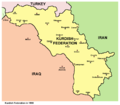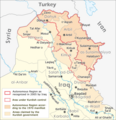
A | B | C | D | E | F | G | H | CH | I | J | K | L | M | N | O | P | Q | R | S | T | U | V | W | X | Y | Z | 0 | 1 | 2 | 3 | 4 | 5 | 6 | 7 | 8 | 9
This is a list of Kurdish dynasties, countries and autonomous territories. The Kurds are an Iranian people without their own nation state, they inhabit a geo-cultural region known as "Kurdistan" which lies in east Turkey, north Syria, north Iraq and west Iran. (For more information see Origin of the Kurds.)[1][2]
8th-19th century states

Prior to the Ayyubid dynasty (until 1171)
- Hadhabanis (906–1080)
- Aishanids (912–961)[3]
- Daysam's Adharbayjan (938–955)[4]
- Shaddadids (951–1199)[5]
- Rawwadids (955–1071)
- Hasanwayhids (959–1014)[6]
- Marwanids (983–1096)[5]
- Annazids (990/91[7][8]–1117)[7]
- Shabankara (11th century–12th century)[9][10]
- Principality of Eğil (1049–1864)[11]
- Hazaraspids (1115–1425)
- Zakarids (1161–1360)[12][13][14]
- Ayyubid dynasty (1171–1341)[15]
After the Ayyubid dynasty (after 1171)
- Emirate of Kilis (1181/1183–1610)[16]
- Principality of Bitlis (1187–1847)
- Emirate of Şirvan (?–1840s)[17]
- Emirate of Çemişgezek (13th century–1663)[18]
- Principality of Donboli (1210–1799)[19]
- Emirate of Bingöl (1231–1864)[20]
- Emirate of Hasankeyf (1232[20]–1524[20])
- Mukriyan (14th century–19th century)[21]
- Vassaldom of Ardalan (14th century[22]–1865 or 1868[23][24])
- Principality of Zirqan (1335–1835)
- Emirate of Bahdinan (1339[25]–1843[26])
- Emirate of Hakkâri (Before 1380s–1845)[27]
- Principality of Suleyman[28] (15th century–1838)
- Principality of Mahmudi (1406–1839)[29]
- Zarrinnaal Dynasty (1448–1925)
- Emirate of Palu (1495–1845)[30]
- Emirate of Pazooka (1499–1587)[31]
16th century onwards
- Baban (16th century–1850)[32]
- Emirate of Bradost (1510–1609)[33]
- Emirate of Bohtan (before 1514–1847)[34]
- Emirate of Soran (before 1514[35]–1836[36])
- Principality of Pinyaşi (1548–1823)[37]
- Sarab Khanate (18th century)[38]
- Zand dynasty (1750–1794) – The dynasty is of Kurdish Lak origin.[39][40]
- Tabriz Khanate (1757–1799)[38]
- Hasan Khan dynasty in Pish-e Kuh (1795–1820)[41]
- Emirate of Miks (?–1846)[42]
20th and 21st century states
- Kurdish State (1918–1919)
- Kingdom of Kurdistan (1921–1924 and 1925)
- Kurdistan Uezd (1923–1929)
- Kurdistan Okrug (1930)
- Republic of Ararat (1927–1931)
- Republic of Mahabad (1946–1947)
- Republic of Laçin (1992)[43]
- Islamic Emirate of Byara (2001–2003)
-
Provisions of the Treaty of Sèvres for an independent Kurdistan (in 1920)
-
The Republic of Mahabad between 1946 and 1947
-
The Islamic Emirate of Byara (black) at their peak, controlling most of the Halabja Governorate
Current entities
- Kurdistan Region (autonomous region in Iraq, 1970–present)
- Autonomous Administration of North and East Syria (self-proclaimed autonomous region declared during the Syrian Civil War by the PYD) (2012–present)
-
Kurdistan Region in 1975
-
Kurdistan Region in 1998
-
Kurdistan Region in 2012
-
Current situation of the Kurdistan Region
Dynasties partly of Kurdish descent
- Safavid dynasty (1501–1736) – The dynasty was partly of Kurdish origin.[44][45][46]
See also
- Kurdish emirates
- Kurdistan Eyalet
- House of Kayus
- Corduene
- A Modern History of the Kurds by David McDowall
Bibliography
- Aboona, Hirmis (2008), Assyrians, Kurds, and Ottomans: Intercommunal Relations on the Periphery of the Ottoman Empire, Cambria Press, ISBN 9781604975833
- Baluken, Yusuf (2017), Çend Dokument ji Serdema Mîrektiya Melkîşî (in Kurdish), vol. 7, Jimar
- Amoretti, Biancamaria Scarcia; Matthee, Rudi (2009). "Ṣafavid Dynasty". In Esposito, John L. (ed.). The Oxford Encyclopedia of the Islamic World. Oxford University Press.
Of Kurdish ancestry, the Ṣafavids started as a Sunnī mystical order (...)
- Matthee, Rudi (2005). The Pursuit of Pleasure: Drugs and Stimulants in Iranian History, 1500-1900. Princeton University Press. p. 18.
The Safavids, as Iranians of Kurdish ancestry and of nontribal background (...)
- Matthee, Rudi (2008). "SAFAVID DYNASTY". Encyclopædia Iranica.
As Persians of Kurdish ancestry and of a non-tribal background, the Safavids (...)
- Savory, Roger (2008). "EBN BAZZĀZ". Encyclopædia Iranica. Vol. VIII. Fasc. 1. p. 8.
This official version contains textual changes designed to obscure the Kurdish origins of the Safavid family and to vindicate their claim to descent from the Imams.
- Başçı, Veysel (2019), "Dunbulî Beyliği Tarihi ve Tarihi Kronikleri [XIII-XVIII. YY.]", Kadim Akademi SBD (in Turkish), 3 (2): 63–114, retrieved 28 May 2020
- Behn, W. (1988), "BĀBĀN", Encyclopedia Iranica, vol. III, 3
- Büchner, V. F. (2012), "S̲h̲abānkāra", Encyclopaedia of Islam, Brill Publishers, doi:10.1163/2214-871X_ei1_SIM_5253, ISBN 9789004082656
- Dehqan, Mustafa; Genç, Vural (2019), "The Kurdish Emirate of Brādōst, 1510-1609", Oriente Moderno, 99 (3): 306–320, doi:10.1163/22138617-12340222, S2CID 213564665, retrieved 30 January 2021
- Ebraheem, Sharameen (2013), The Impact of Architectural Identity on Nation Branding: The Case Study of Iraqi Kurdistan. (PDF), Manchester Metropolitan University's Research Repository
- Eppel, Michael (2018), "The Kurdish emirates", Routledge Handbook on the Kurds, Routledge Handbooks Online, pp. 35–47, doi:10.4324/9781315627427-4, ISBN 978-1-138-64664-3, S2CID 186808301, retrieved 1 May 2020
- Flynn, Thomas O. (2017), The Western Christian Presence in the Russias and Qājār Persia, c.1760–c.1870, Brill Publishers, ISBN 9789004313545
- Ghalib, Sabah Abdullah (2011), The Emergence of Kurdism with Special Reference to the Three Kurdish Emirates within the Ottoman Empire, 1800-1850 (PDF), University of Exeter, retrieved 1 May 2020
- Gunter, Michael M. (2010), Historical Dictionary of the Kurds, Scarecrow Press, ISBN 9780810875074
- Hakan, Sinan (2002), Müküs Kürt Mirleri Tarihi ve Han Mahmud (in Turkish), Pêrî Yayınları, ISBN 9789758245581
- Houtsma, M. Th. (1993), E. J. Brill's First Encyclopaedia of Islam, 1913-1936, Brill Publishers
- Kaplan, Yaşar (2015), Pınyanış Hükümeti/Government of Pinyanish (in Turkish), Hakkari University
- Maisel, Sebastian (2018), The Kurds: An Encyclopedia of Life, Culture, and Society, ABC-CLIO, ISBN 978-1-4408-4257-3
- Meinecke, Michael (1996), Patterns of Stylistic Changes in Islamic Architecture: Local Traditions Versus Migrating Artists, NYU Press, ISBN 9780814754924
- Petrushevsky, Ilya Pavlovich (1949), Очерки по истории феодальных отношений в Азербайджане и Армении в XVI-начале XIX вв (in Russian), Saint Petersburg State University
- Soyudoğan, Muhsin (2015), Tribal Bandistry in Ottoman Ayntab (1690-1730), Bilkent University
- Spuler, B. (2012), "Faḍlawayh", Encyclopaedia of Islam, Brill Publishers, doi:10.1163/1573-3912_islam_SIM_2233, ISBN 9789004161214
- Top, Mehmet (1998), "Hoşaptaki Mahmudi Beylerine Ait Mimari Eserler", Academia SBD (in Turkish), 3 (2)
- Verheij, Jelle (30 March 2018), ""The year of the firman:" The 1895 massacres in Hizan and Şirvan (Bitlis vilayet)", Études arméniennes contemporaines (10): 125–159, doi:10.4000/eac.1495, ISSN 2269-5281, retrieved 24 May 2020
- Ünal, Mehmet Ali (1999), XVI. yüzyılda Çemişgezek sancağı (in Turkish)
- Peacock, Andrew (2017). "RAWWADIDS". Encyclopædia Iranica.
RAWWADIDS a family of Arab descent Their Kurdicized descendants ruled over Azerbaijan and parts of Armenia in the second half of the 10th and much of the 11th century.
References
- ^ Limbert, John (1968). "The Origins and Appearance of the Kurds in Pre-Islamic Iran". Iranian Studies. 1 (2): 48. doi:10.1080/00210866808701350. JSTOR 4309997 – via JSTOR.
- ^ James, Boris (September 2006). "Uses and Values of the Term Kurd in Arabic Medieval Literary Sources". Institut Kurde. Retrieved 4 April 2021.
- ^ Tor, D.G. (2017). The Abbasid and Carolingian Empires: Studies in Civilizational Formation. Brill Academic Pub. pp. 54–55.
- ^ Bosworth (1994). "Daysam". Iranica Online.
- ^ a b Amir Hassanpour, Nationalism and Language in Kurdistan, 1918-1985, Mellen Research University Press, 1992, p. 50.
- ^ Gunter (2010), p. 117.
- ^ a b Aḥmad, K. M. (1985). "ʿANNAZIDS". Iranica Online. II.
- ^ Pezeshk, Manouchehr; Negahban, Farzin (2008). "ʿAnnāzids". In Madelung, Wilferd; Daftary, Farhad (eds.). Encyclopaedia Islamica Online. Brill Online. ISSN 1875-9831.
- ^ Büchner 2012.
- ^ Spuler 2012.
- ^ Han, Şeref (Çev. İbrahim Sunkur) (2016). Şerefname. Van: Sîtav. p. 204. ISBN 978-605-66520-1-1.
- ^ Alexei Lidov, 1991, The mural paintings of Akhtala, p. 14, Nauka Publishers, Central Dept. of Oriental Literature, University of Michigan, ISBN 5-02-017569-2, ISBN 978-5-02-017569-3, It is clear from the account of these Armenian historians that Ivane's great grandfather broke away from the Kurdish tribe of Babir
- ^ Vladimir Minorsky, 1953, Studies in Caucasian History, p. 102, CUP Archive, ISBN 0-521-05735-3, ISBN 978-0-521-05735-6, According to a tradition which has every reason to be true, their ancestors were Mesopotamian Kurds of the tribe (xel) Babirakan.
- ^ Richard Barrie Dobson, 2000, Encyclopedia of the Middle Ages: A-J, p. 107, Editions du Cerf, University of Michigan, ISBN 0-227-67931-8, ISBN 978-0-227-67931-9, under the Christianized Kurdish dynasty of Zak'arids they tried to re-establish nazarar system...
- ^ R. S. Humphreys, Ayyubids, "Encyclopaedia Iranica", (August 18, 2011),
- ^ Soyudoğan (2015).
- ^ Verheij (2018).
- ^ Ünal (1999), pp. 262–263.
- ^ Başçı (2019), p. 63.
- ^ a b c Maisel (2018), p. 131.
- ^ Hassanpour, Amir (1989). "BŪKĀN". Encyclopedia Iranica. IV.
- ^ Oberling, P. "BANĪ ARDALĀN". Encyclopædia Iranica. Retrieved 2011-09-21.
- ^ David Mcdowall (1996). The Kurds (PDF). Minority Rights Group International Report. p. 20. Retrieved 2 May 2020.
- ^ Najat Abdulla-Ali (2006). Empire, frontière et tribu Le Kurdistan et le conflit de frontière turco-persan (1843-1932) (in French). p. 159.
- ^ Aboona (2008), p. 175.
- ^ Eppel (2018), p. 42.
- ^ Flynn (2017), p. 663.
- ^ Houtsma (1993), p. 1144-1445.
- ^ Top (1998), p. 6-9.
- ^ Nusret Aydın, Diyarbakır and Mirdasiler History, 2011, p. 304-305
- ^ Han, Şeref (Çev. İbrahim Sunkur) (2016). Şerefname. Van: Sîtav. p. 375. ISBN 978-605-66520-1-1.
- ^ Behn (1988).
- ^ Dehqan & Genç (2019).
- ^ Jongerden, Joost; Verheij, Jelle (2012-08-03). Social Relations in Ottoman Diyarbekir, 1870-1915. BRILL. p. 60. ISBN 978-90-04-23227-3.
- ^ Ghalib (2011), p. 50.
- ^ Ebraheem (2013), p. 235.
- ^ Kaplan (2015), p. 4.
- ^ a b Tapper, Richard (2010). "Shahsevan". Encyclopedia Iranica.
- ^ Perry, John. "ZAND DYNASTY". iranicaonline.org. Encyclopædia Iranica. Retrieved 24 March 2017.
The founder of the dynasty was Moḥammad Karim Khan b. Ināq Khan (...) of the Bagala branch of the Zand, a pastoral tribe of the Lak branch of Lors (perhaps originally Kurds; see Minorsky, p. 616) (...)
- ^ ...the bulk of the evidence points to their being one of the northern Lur or Lak tribes, who may originally have been immigrants of Kurdish origin., Peter Avery, William Bayne Fisher, Gavin Hambly, Charles Melville (ed.), The Cambridge History of Iran: From Nadir Shah to the Islamic Republic, Cambridge University Press, 1991, ISBN 978-0-521-20095-0, p. 64.
- ^ Dehqn, Mustafa (2009). "Arkawāzī and His Baweyaļ: A Feylî Elegiac Verse from Piştiku". Iranian Studies. 42 (3): 409–422. doi:10.1080/00210860902907362. JSTOR 25597563. S2CID 159957313.
- ^ Hakan (2002).
- ^ Kemper, Michael; Conermann, Stephan (2011). The Heritage of Soviet Oriental Studies. Routledge. p. 92. ISBN 978-1-136-83854-5.
In 1992 the area of Laçin was occupied by Armeian forces; a "Kurdish Republic of Laçin" was subsequently declared by local Kurds, but this remained a rather short-lived - not to say stillborn - adventure
- ^ Matthee 2005, p. 17; Matthee 2008.
- ^ Amoretti & Matthee 2009.
- ^ Savory 2008, p. 8.
External links
Text je dostupný za podmienok Creative Commons Attribution/Share-Alike License 3.0 Unported; prípadne za ďalších podmienok. Podrobnejšie informácie nájdete na stránke Podmienky použitia.
Antropológia
Aplikované vedy
Bibliometria
Dejiny vedy
Encyklopédie
Filozofia vedy
Forenzné vedy
Humanitné vedy
Knižničná veda
Kryogenika
Kryptológia
Kulturológia
Literárna veda
Medzidisciplinárne oblasti
Metódy kvantitatívnej analýzy
Metavedy
Metodika
Text je dostupný za podmienok Creative
Commons Attribution/Share-Alike License 3.0 Unported; prípadne za ďalších
podmienok.
Podrobnejšie informácie nájdete na stránke Podmienky
použitia.
www.astronomia.sk | www.biologia.sk | www.botanika.sk | www.dejiny.sk | www.economy.sk | www.elektrotechnika.sk | www.estetika.sk | www.farmakologia.sk | www.filozofia.sk | Fyzika | www.futurologia.sk | www.genetika.sk | www.chemia.sk | www.lingvistika.sk | www.politologia.sk | www.psychologia.sk | www.sexuologia.sk | www.sociologia.sk | www.veda.sk I www.zoologia.sk








